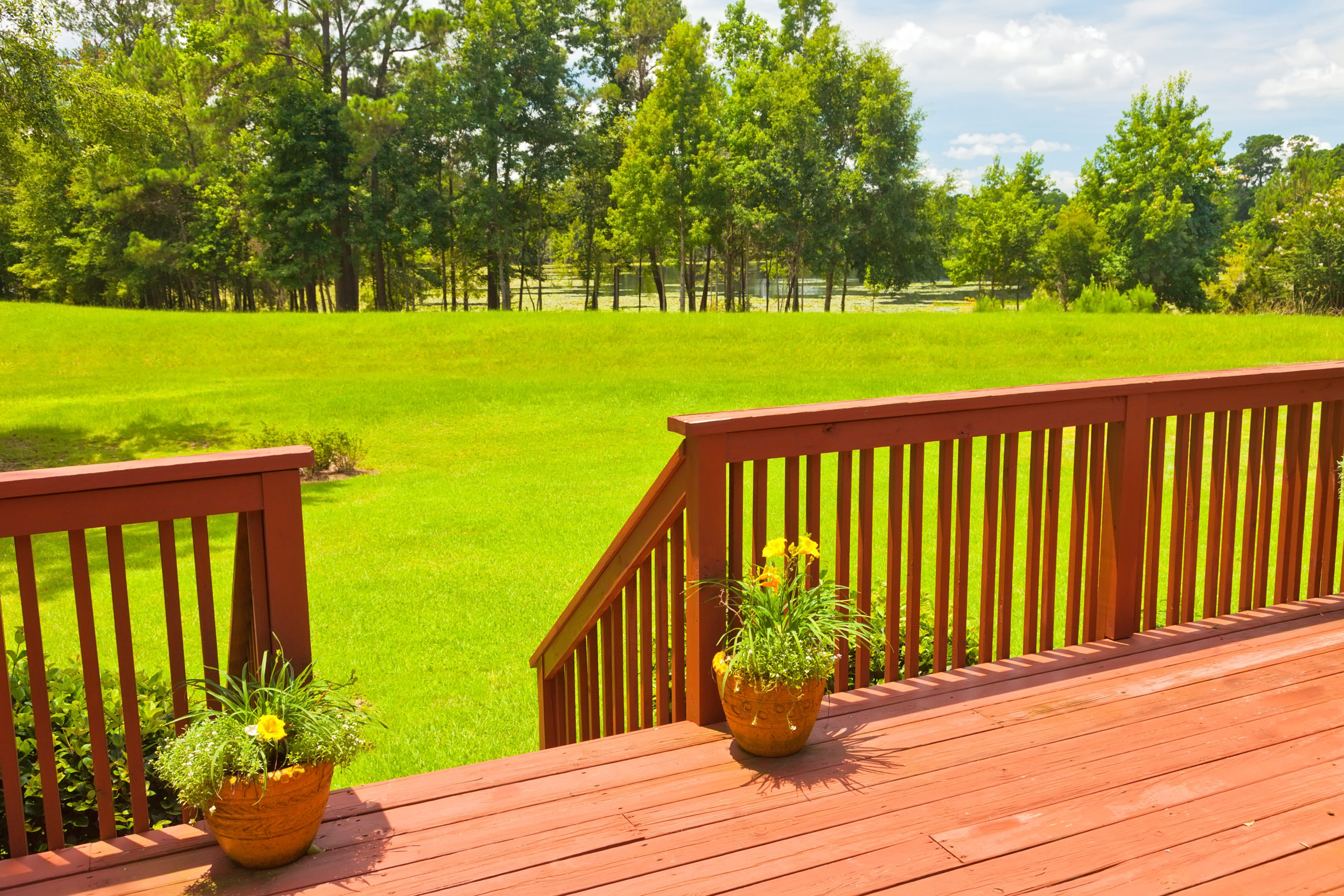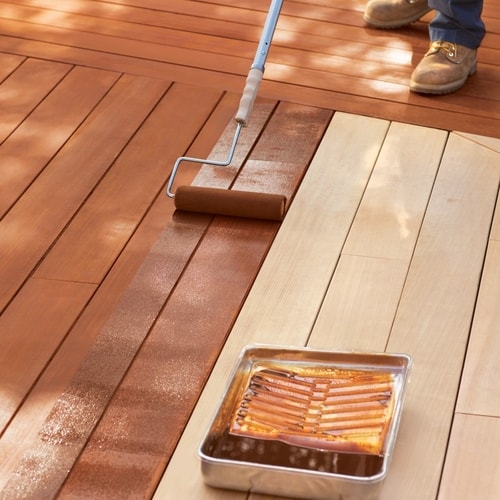Deck Staining Marvels: Changing Your Outside Oasis
Picking the Right Spot for Your Fence: Tips and Considerations
When it comes to boosting the appearance and keeping of your fence, picking the appropriate discolor is critical. We will certainly discover the different kinds of fencing stains, factors to think about before selecting a discolor, pointers for preparing your fencing for staining, and the distinctions between water-based and oil-based discolorations. In addition, we will certainly delve right into picking the right discolor shade to match your fence and enhance your exterior area.
Understanding Various Kinds Of Fencing Spots

On the various other hand, water-based stains are made from acrylic or latex and supply a much more refined color to the timber. They create a safety movie on the surface area of the timber, preventing wetness from seeping in and protecting versus UV damages. Water-based spots are much easier to clean up and have a quicker drying time compared to oil-based spots. They are additionally less most likely to fade or fracture with time.
Selecting in between oil-based and water-based stains depends on various factors, including individual choice, the wanted appearance, and the degree of maintenance needed. Oil-based spots are suggested for surround high-traffic areas or those continuously subjected to severe climate condition. fence staining and sealing. Water-based discolorations, on the other hand, are a prominent selection for fencings in houses where appearance and convenience of usage are very important
When selecting the appropriate stain for their fence,Recognizing the differences between oil-based and water-based stains helps homeowners make an educated choice. Thinking about the details requirements of the fence, such as its location, exposure to sunlight, and desired visual, will certainly ensure that the chosen tarnish provides long-lasting protection and enhances the total elegance of the fence.
Elements to Think About Before Picking a Discoloration

An additional element to consider is the kind of wood your fence is made from. Different kinds of wood absorb discolorations in different ways, leading to varying degrees of color strength and longevity. Softwoods like want may call for more regular staining contrasted to hardwoods like cedar or redwood. In addition, specific timbers may be more vulnerable to issues like rot or insect problem, which may influence the choice of tarnish to protect the fencing and safeguard.
The climate and weather condition conditions in your location must additionally be taken into account. You may need a stain that offers extra protection against moisture and UV rays if you live in a location with rough winters or high humidity. Also, if your fence is subjected to direct sunshine for extended periods, a stain with UV preventions can aid stop fading and staining.
Finally, it is very important to consider your wanted visual. Different stains offer numerous shades and finishes, permitting you to personalize the appearance of your fencing (fence staining and sealing). Consider the total design and design of your residential property, in addition to any neighborhood guidelines or house owner association standards that may determine the appropriate stain shades
Tips for Preparing Your Fence for Discoloration
To prepare your fence for discoloration, begin by thoroughly cleansing the surface area using a light cleaning agent and a pressure washer or scrub brush. Cleansing the fence is an important action as it eliminates dust, gunk, and any type of previous coverings that might disrupt the discoloration process. Begin by moistening the fence with water and after that apply a light detergent making use of a scrub brush or a pressure washing machine with a low-pressure setting. Rub the surface delicately, paying extra focus to areas with persistent spots or mold and mildew. Wash the fence thoroughly with tidy water to eliminate all traces of detergent.
This step is vital as tarnishing a wet or damp surface area can lead to Get More Information inadequate attachment and an irregular coating. Make certain that the fencing is entirely dry prior to continuing with the discoloration procedure.
Before staining, examine the fence for any kind of problems, such as loosened boards or nails. This product helps to open up the timber pores, permitting the tarnish to pass through a lot more efficiently and uniformly.

Contrasting Oil-Based and Water-Based Discolorations
When selecting a tarnish for your fence, it is essential to compare the attributes and advantages of oil-based and water-based spots. Both kinds of stains have their very own advantages and factors to consider, so it is critical to recognize the differences between them.
Oil-based stains are understood for their sturdiness and resistance to tear and put on. They pass through deeply right into the wood, supplying excellent security against the components. They also boost the all-natural elegance of the wood by highlighting its grain and appearance. Additionally, oil-based stains tend to last longer than water-based stains, making them a preferred choice for fencings.
On the various other hand, water-based spots are much more environmentally pleasant and much easier to clean up. They may not provide the very same level of protection as oil-based discolorations, particularly in severe climate problems.
Eventually, the option between oil-based and water-based discolorations depends on your details requirements and choices. Think about factors such as sturdiness, ecological influence, and simplicity of application when making your choice. Consulting with a specialist or seeking suggestions from experts can likewise aid ensure that you pick the right discolor for your fencing.
Choosing the Right Spot Shade for Your Fencing
The selection of a proper tarnish color for your fencing is an essential aspect of improving its visual appeal and matching the total layout of your outdoor area (fence cleaning). The best stain shade can transform a level, average fence right into a striking centerpiece that adds deepness and character to your building
When selecting a stain color for your fencing, it is necessary to take into consideration the style and style of your home. Natural tones such as browns and neutrals can develop a warm and welcoming appearance if you have a timeless or standard design home. On the other hand, if you have a modern or modern home, you may take into consideration choosing for strong and vibrant shades that make a statement.
One more variable to take into consideration is the all-natural surroundings of your property. If you have a great deal of plant, a discolor color that matches the natural landscape, such as eco-friendlies or crimsons, can produce a natural and harmonious appearance.
Furthermore, it's worth thinking about the upkeep needed for various tarnish shades. Lighter colors tend to show dirt and wear more easily, while darker colors can hide imperfections and need less regular touch-ups.
Eventually, the option of discolor shade for your fencing must show your individual design and preferences - fence staining and sealing. Put in the time to explore various options and get in touch with with experts if required, to ensure that you select the best tarnish color that enhances the charm and charm of your fencing
Verdict
In conclusion, when it concerns selecting the ideal tarnish for your fencing, it is very important to understand the different sorts of spots offered and think about variables such as durability and desired appearance. Preparing the fence properly before staining is essential for achieving optimal results. Furthermore, comparing oil-based and water-based stains can help identify the most effective option for your specific needs. Lastly, picking the appropriate tarnish shade can improve the overall looks of your fencing.
We will explore the various kinds of fencing discolorations, aspects to think about before choosing a stain, tips for preparing your fencing for discoloration, and the differences in between oil-based and water-based spots.Differentiating between water-based and oil-based stains is crucial when understanding various kinds of fencing spots. Water-based discolorations are easier to cleanse up and have a faster drying out time compared to oil-based spots. In addition, oil-based spots often tend to last longer than water-based stains, making them a prominent selection for fences.
In verdict, when it comes to choosing the best tarnish for your fence, it is essential to recognize the different types of spots readily available and think about aspects such as sturdiness and wanted appearance.